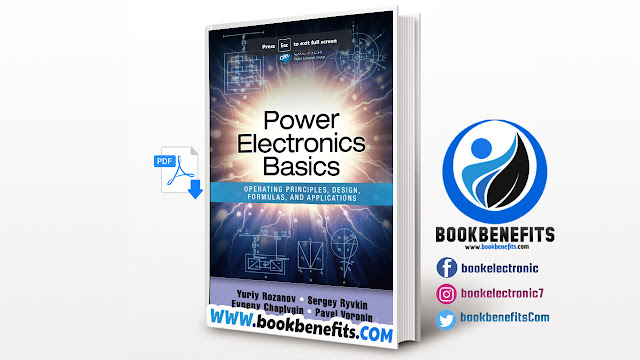Download Power electronics basics: operating principles, design, formulas, and applications PDF
Power electronics basics
Picture Of the Book:
Power electronics basics: operating principles, design, formulas, and applications
About Of the Book:
"Power Electronics Basics: Operating Principles, Design, Formulas, and Applications" is a book written by a team of authors including Evgeny Chaplygin, Yuriy Rozanov, Sergey Ryvkin, and Pavel Voronin. It focuses on the fundamental principles, design considerations, formulas, and applications of power electronics.
The book covers various topics related to power electronics, including the basic operating principles of power electronic devices such as diodes, transistors, and thyristors. It delves into the principles of operation, design considerations, and practical applications of various power electronic converters and inverters, including DC-DC converters, DC-AC inverters, and AC-DC rectifiers. The book also discusses topics such as power factor correction, electromagnetic compatibility (EMC), and thermal management in power electronic systems.
In addition to the operating principles, the book provides design guidelines, formulas, and practical examples for designing power electronic systems. It covers topics such as power semiconductor devices, power electronic circuits, control strategies, and thermal design considerations. The book also includes numerous illustrations, diagrams, and examples to help readers understand the concepts and applications of power electronics.
Overall, "Power Electronics Basics" serves as a comprehensive reference for students, engineers, and researchers who are interested in understanding the fundamentals of power electronics and its applications in various fields such as energy conversion, motor drives, renewable energy systems, and more.
Efficiency of the use of electrical energy can be significantly improved
by means of power electronics. The latter is the fastest growing field of
electrical engineering. This book is devoted to the world of power electronics. It presents and explains the basics and the most important concepts of power electronics. It also gives us the fundamental knowledge
for analysis and design in its area. Readers will find many practical
examples that demonstrate the achievements and prospects of developing and using power electronics including mainstream such as renewable
energy production, transferring, and distribution.
This book will be of interest to many readers including graduate students, industry professionals, researchers, and academics.
The authors express their gratitude to all who helped in the creation
of this book.
Contents Of the Book:
Chapter 1 Basic concepts and terms in power electronics
1.1 Conversion of electrical energy: Classification of converters.
1.2 Output parameters and characteristics of converters
1.3 Influence of converters on the grid
1.4 Basic converter parameters
1.5 ac and dc filters
1.5.1 Dynamic processes in filters References
Chapter 2 Semiconductor power switches and passive components
2.1 Introduction.
2.2 Power diodes
2.2.1 Power diodes with p+–n−–n+ structure
2.2.2 Schottky power diodes
2.2.3 Pulsed diodes
2.3 Power bipolar transistors.
2.4 Thyristors
2.4.1 Controllable semiconductor switches with p–n–p–n structure
2.4.2 Power photothyristors
2.4.3 Symmetric thyristors
2.5 Switched thyristors
2.5.1 The GTO thyristor
2.5.2 Gate-commutated thyristors (GCTs, ETOs, MTOs)
2.5.3 The integrated GCT thyristor
2.5.4 The MOS-controlled thyristor
2.6 Field transistors
2.6.1 Powerful short-channel MOS transistors
2.6.2 CoolMOS technology
2.6.3 Static induction transistors
2.7 The IGBT
2.7.1 Epitaxial (PT) and homogeneous (NPT) IGBT structures
2.7.2 Trench-gate IGBT
2.7.3 The trench-FS and SPT
2.7.4 The CSTBT and SPT+
2.8 Switch modules
2.8.1 Topology of integrated power modules
2.8.2 Assembly of power modules
2.8.3 Connecting the module to the power circuit
2.9 Power assemblies
2.9.1 Integrated power modules
2.9.2 Intellectual power module
2.9.3 Power assemblies of basic topology (1/2B2, B2, B6) with a dc element and a cooling system
2.9.4 Power assemblies of B6U + B6I topology: Inverter platforms
2.9.5 Power bipolar assemblies
2.10 Applications of power switches
2.11 Cooling systems for semiconductor power devices
2.11.1 Radiators for air cooling
2.11.2 Radiators for liquid cooling
2.12 Promising developments in power electronics
2.12.1 Power switches based on SiC
2.12.2 Highly integrated power modules
2.13 Control of semiconductor power switches
2.14 Passive components
2.14.1 Introduction
2.14.2 Electromagnetic components
2.14.2.1 Basic characteristics of ferromagnetic materials
2.14.2.2 Influence of high frequencies and nonsinusoidal voltage on the operation of transformers and reactors
2.14.3 Capacitors: Basic definitions and characteristics
2.14.3.1 Influence of the form and frequency of the
voltage on capacitor operation References
Chapter 3 Control of power electronic devices
3.1 Mathematical models
3.1.1 One-dimensional and multidimensional models.
3.1.2 Linear and nonlinear systems—Linearization
Chapter 4 Line-commutated converters
Chapter 5 Conversion from direct current to direct current
Chapter 6 Inverters and ac converters based on completely controllable switches
Chapter 7 Pulse-width modulation and power quality control
Chapter 8 Resonant converters
Chapter 9 Multilevel, modular, and multicell converter
Chapter 10 Applications of power electronics
Information Of the Book:
Title: Power electronics basics operating principles, design, formulas, and applications Download PDF
Size: 8 Mb
Pages: 478
Year: 2015
Format: PDF
Language: English
Author: Arijit Saha & Nilotpal Manna
Download Book

